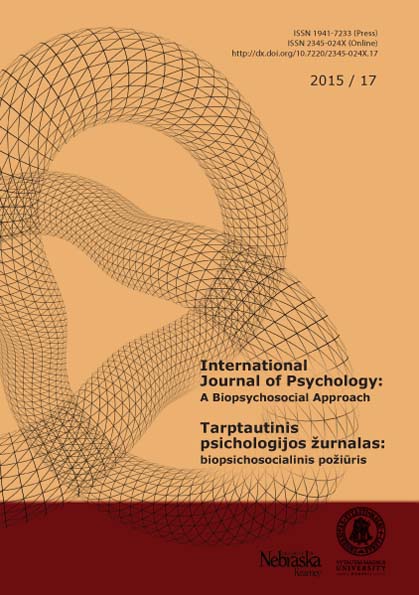SKIRTINGO AMŽIAUS ŽMONIŲ VEIDŲ ATPAŽINIMO YPATUMAI LIETUVOS POPULIACIJOJE
FACE RECOGNITION PECULIARITIES OF DIFFERENT AGE PEOPLE IN A LITHUANIAN SAMPLE
Author(s): Albina Saikauskienė, Aušra DaugirdienėSubject(s): Psychology
Published by: Vytauto Didžiojo Universitetas
Keywords: Face recognition; Upright faces; Inverted faces
Summary/Abstract: The paper presents empirical data and analyses biological and psy¬chological face recognition aspects. The function of face recognition is particularly important in the process of social interaction. Despite the experience acquired in ev¬eryday face recognition, the ability to recognize faces weakens with aging. The issue of face recognition is not completely new on a worldwide scale, however, researchers present conflicting results and raise new questions about this phenomenon. What is more, in Lithuania, research on face recognition is developed not enough. It mo¬tivated us to initiate this study as well as data from researches carried out in other countries that found cultural differences in the processing of facial information (Blais et al., 2008). For example, adults from China showed a disposition to process informa¬tion holistically, whereas individuals from Britain – to process information analytically (Kelly et al., 2011). Purpose. The aims of the research were: 1) to determine at what age people recog¬nize faces best and when this ability starts worsening; 2) to determine the differences in face recognition ability among different age groups. Method. The experiment was carried out. The methodology of the research was based on the similar type of research (Germine, Duchaine, Nakayama, 2011; Hay, Cox, 2000; Tanaka, Farah, 1993). 80 black-and-white photographs depicting people of different ages were presented to the research participants for recognition. Results and conclusions. The research results revealed that the ability to recognize faces reaches its optimal level in the interval of 20–35 years of age. The comparison between different age groups showed that young adults (20–35 years old) better than adolescents (11–18 years old) and senior adults (56–75 years old) memorized and rec¬ognized faces of different age people they had already seen. Veidų atpažinimo funkcija socialinės sąveikos procese ypač svarbi. Nepaisant kasdien įgyjamos patirties, pastebimas senyvo amžiaus žmonių gebėjimo atpažinti veidus silpnėjimas. Pasaulyje veidų atpažinimo tema nėra visiškai nauja, tačiau tyrėjai pateikia prieštaringus rezultatus ir iškelia papildomus klausimus. Tikslas. Tyrimu siekiama nustatyti, kokiame amžiuje žmonės geriausiai atpažįsta veidus, atskleisti šio gebėjimo silpnėjimo pradžią, nustatyti gebėjimo atpažinti vei-dus skirtumus tarp įvairaus amžiaus žmonių grupių. Metodika. Tyrime naudotas eksperimento metodas. Tyrimo metodika parengta atsižvelgiant į panašaus pobūdžio tyrimus (Germine et al., 2011, Hay, Cox, 2000, Tanaka, Farah, 1993). Tiriamiesiems buvo pateikta 80 nespalvotų skirtingo amžiaus žmonių nuotraukų, kurias jie turėjo atpažinti. Rezultatai ir išvados. Tyrimo rezultatai atskleidė, kad gebėjimas atpažinti veidus optimalus pasiekus jauno suaugusiojo amžių (20–35 m.). Palyginus skirtingas amžiaus grupes paaiškėjo, kad jauni suaugusieji (20–35 m.) anksčiau matytus įvairaus amžiaus žmonių veidus įsimena ir atpažįsta geriau nei paaugliai (11–18 m.) ir vyresnio amžiaus asmenys (56–75 m.).
Journal: Tarptautinis psichologijos žurnalas: biopsichosocialinis požiūris
- Issue Year: 2015
- Issue No: 17
- Page Range: 7-23
- Page Count: 17
- Language: English

